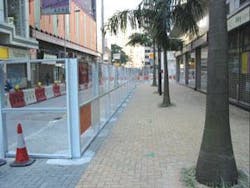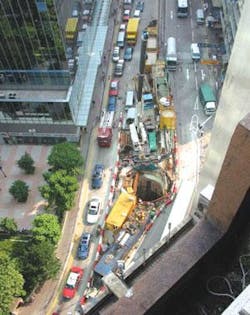Sewer tunnel breakthrough advances underground infrastructure management
Thomas Kane, Wilson Mok
Black & Veatch’s successful Hong Kong project proves large-scale construction of curved alignment sewerage tunnels in busy, urban areas can be completed on time with minimal disruption.
Upon completion of the last tunnel drive and tunnel-boring machine (TBM) breakthrough in June 2005, Wan Chai East and North Point (WCE & NP) Sewerage Project participants performing the trunk sewers contract breathed a collective sigh of relief. Engineers from the Hong Kong Drainage Services Department and Black & Veatch celebrated their success in designing and constructing curved alignment tunnels that minimized disruption in two of the busiest urban areas in Hong Kong.
The Drainage Services Department (DSD) of the Government of the Hong Kong Special Administrative Region launched the WCE & NP Sewerage Project to improve the wastewater infrastructure and capacity in Wan Chai East and North Point areas of Hong Kong in order to meet current and anticipated development needs. It consists of five contracts, two of which were completed in 2001, with the three remaining contracts currently in progress.
Tricky trunk sewers
Black & Veatch has been responsible for the design and supervision of construction for all of the contracts under the WCE & NP Sewerage Project. One of the current contracts, the HK$427 million (US$ 55 million) trunk sewers contract that commenced in late May 2002, has presented many challenges but also has paved the way for larger-scale construction of sewerage tunnels in busy urban areas. The contract is on schedule for completion in December 2005.
The trunk sewers contract involved the construction of 4.4 km of sewers with diameter of 600 mm, 1200 mm, and 1800 mm, with a depth ranging from 4.5 m to 18 m, using slurry-operated TBMs in highly variable ground conditions in two urban areas. This project marks the first time that curved alignment tunnels have been constructed in Hong Kong. The curved alignment was especially challenging because one tunnel section had a 404-m-long S-curve alignment that also entailed tunneling through and being received in, already constructed permanent shafts - another first for tunneling technology in Hong Kong.
Photo courtesy of the Drainage Services Department of the Hong Kong SAR Government
Black & Veatch designers and the resident site staff, in conjunction with DSD engineers, carefully reviewed the contractor’s proposals and method statements for the previously constructed permanent shafts and for the TBM travel-through into those shafts. They provided recommendations to help minimize risks and maximize the structural integrity, stability, and water-tight conditions of the shafts and tunnels, during and after the jacking operation. In addition, project staff rigorously controlled the rate of advancement and the horizontal and vertical alignment of the TBM, particularly as it traveled through and into the permanent shafts.
Vibrations induced in the permanent shaft structures were closely monitored to ensure that the structural integrity of the shafts was not impaired. Mass concrete filling was provided as tunneling ballast in the through-permanent shaft, to ensure proper alignment of the jacked pipeline and also to balance water pressure from outside the shaft, thus preventing any unnecessary ground settlement that might result from drawdown of the groundwater table. Special construction joint details were devised to ensure that grouting of the pipeline annulus did not result in any grout influx to the permanent shaft and to ensure the watertightness of the permanent shaft. Removal of the TBM from the receiving shaft required extreme care because the minimum clearance between the shaft walls and the TMB at the narrowest point was only 100 mm.
Special considerations
Safety is given top priority in all aspects of the project, and full consideration is given to the safety of the works, the general public and all of the operatives engaged with related construction. Detailed risk assessments are carried out before any activity can proceed and a safety plan, drawn up by the contractor in full compliance with Hong Kong Regulations and the particular requirements of the Drainage Services Department, was developed and rigorously applied and monitored by Black & Veatch resident site staff.
The need for effective and sensitive public relations was perceived in the planning stages, and both DSD and Black & Veatch were committed to ensuring that it played a paramount role during the construction phase. Information pamphlets, newsletters, and public consultation and liaison meetings have been used to keep the public well informed of the progress of the work. A 24-hour telephone hotline is in force, on each current contract, to enable the public to pose questions, lodge complaints, and make general enquiries on all and any aspects of the project that may affect them.
One example of this public relations commitment was the development and adoption of transparent hoardings by the WCE & NP resident site staff team. The work sites were required under the trunk sewers contract to be enclosed with corrugated-steel sheeted hoarding/fences. However, in order to improve the aesthetics of these hoardings and to lessen the visual impact and intrusion on the site environment, the vast majority of these hoardings are constructed with transparent panels to improve lighting and sightlines and to maintain the visibility of the existing commercial premises and provide greater security for pedestrians, especially at night. They also help to keep the public abreast of the progress of the works, as the works are always in the public view. This transparency also encourages the contractor to keep the sites clean and tidy.
A Traffic Management Liaison Group, involving representatives of all of the relevant transport and regulatory bodies, governs and controls the traffic management measures implemented to facilitate the project works. The group ensures that disruption to traffic and public transport is kept to a minimum and that it can adapt to ever-changing traffic needs.
Neatness and tidiness of the contractors’ operations is a contractual requirement and is emphasized not only to maintain good public relations, but also as a precursor to achieving proper safety standards. The WCE & NP contractors have been enthusiastic participants in the Considerate Contractors Award Scheme, run on an annual basis by the Environment, Transport and Works Bureau of the Hong Kong SAR Government. The trunk sewers contract has won the Silver Grand Prize, in 2003 and 2004, which is a significant achievement given the immensity of the problems posed by carrying out such complicated works in such a congested and sensitive environment.
Use of closed-circuit television at all shaft sites also allows for continuous vigilance of tidiness and also provides a measure of security.
Photo courtesy of the Drainage Services Department of the Hong Kong SAR Government
Trenchless technology is gaining international popularity, especially in densely populated and high-traffic areas where traditional construction methods would be too disruptive. Successful completion of the Wan Chai East and North Point Trunk Sewer contract in Hong Kong gives governments and utilities additional proof that tunnel technology is moving ahead, curved tunnels are more manageable than ever, and nuisance to the public can be minimized.
Authors’ Note
Thomas Kane is the senior resident engineer for Black & Veatch’s Wan Chai East and North Point Sewerage Project. Wilson Mok is the senior resident engineer for Black & Veatch’s Trunk Sewers Contract in Hong Kong. For more information about Black & Veatch, visit www.bv.com.
For more information on the Wan Chai East and North Point Sewerage Project visit www.dsd.gov.hk/our_projects/our_project_type_sewage/index_UID_727.htm.
Photo courtesy of the Drainage Services Department of the Hong Kong SAR Government
International stormwater study assesses BMPs/SUDS
A three-year study of Best Management Practices (BMPs) and Sustainable Urban Drainage Systems (SUDS) resulted in the report Performance and Whole Life Costs of Best Management Practices and Sustainable Urban Drainage Systems, which advances the industry’s practical knowledge of stormwater management techniques and costs.
BMPs and SUDS are measures used in the USA and the UK, respectively, to reduce adverse impacts to receiving waters. The study, collectively funded by the Water Environment Research Foundation (WERF), United Kingdom Water Industry Research (UKWIR) and the Awwa Research Foundation (AwwaRF), was launched to obtain more detailed information associated with selected BMPs and SUDS. Professionals from Black & Veatch led teams in both countries in support of the effort that will improve overall stormwater quality management.
In addition to Black & Veatch, the United Kingdom research team included HR Wallingford, Ltd., and the Urban Water Technology Centre at the University of Abertay, Dundee, Scotland. The US team included the Center for Research in Water Resources of the University of Texas in Austin and Austin-based Glenrose Engineering.
Participants conducted an extensive review of the scientific literature and a survey of existing information on BMPs and SUDS, then performed in-depth assessment of the performance, maintenance requirements and whole-life costs of selected BMPs/SUDS. Evaluation focused on retention ponds, extended detention basins, vegetated swales, bioretention systems, porous pavement and infiltration facilities.
The study also resulted in the development of a whole-life cost model that demonstrates that the level of maintenance had a pronounced effect on whole-life costs for most facilities. Also, in many jurisdictions, vegetation management dominated the maintenance activities rather than sediment, debris and trash removal, or structural repair.
The report is available from the Water Environment Research Foundation (www.werf.org).


